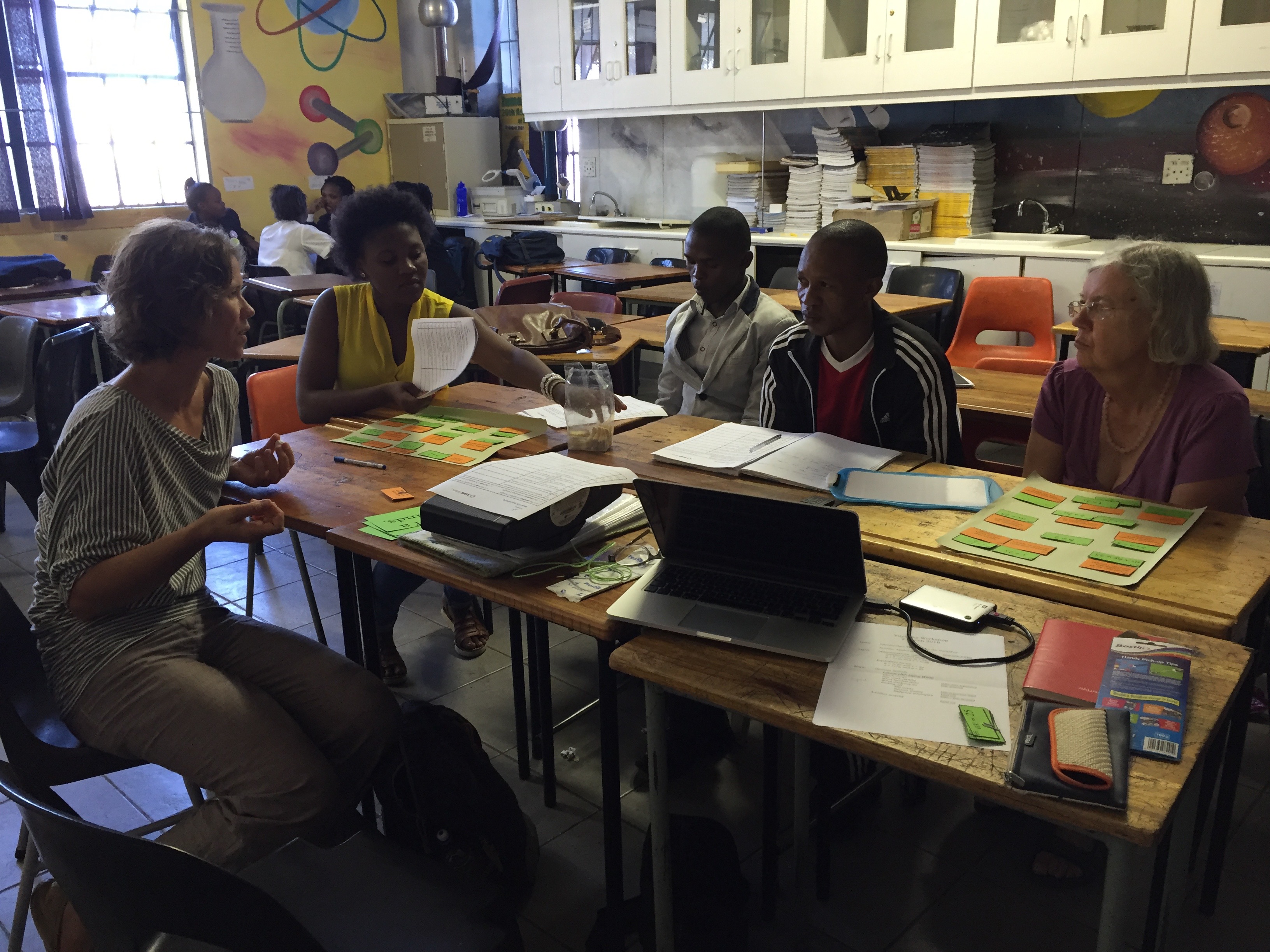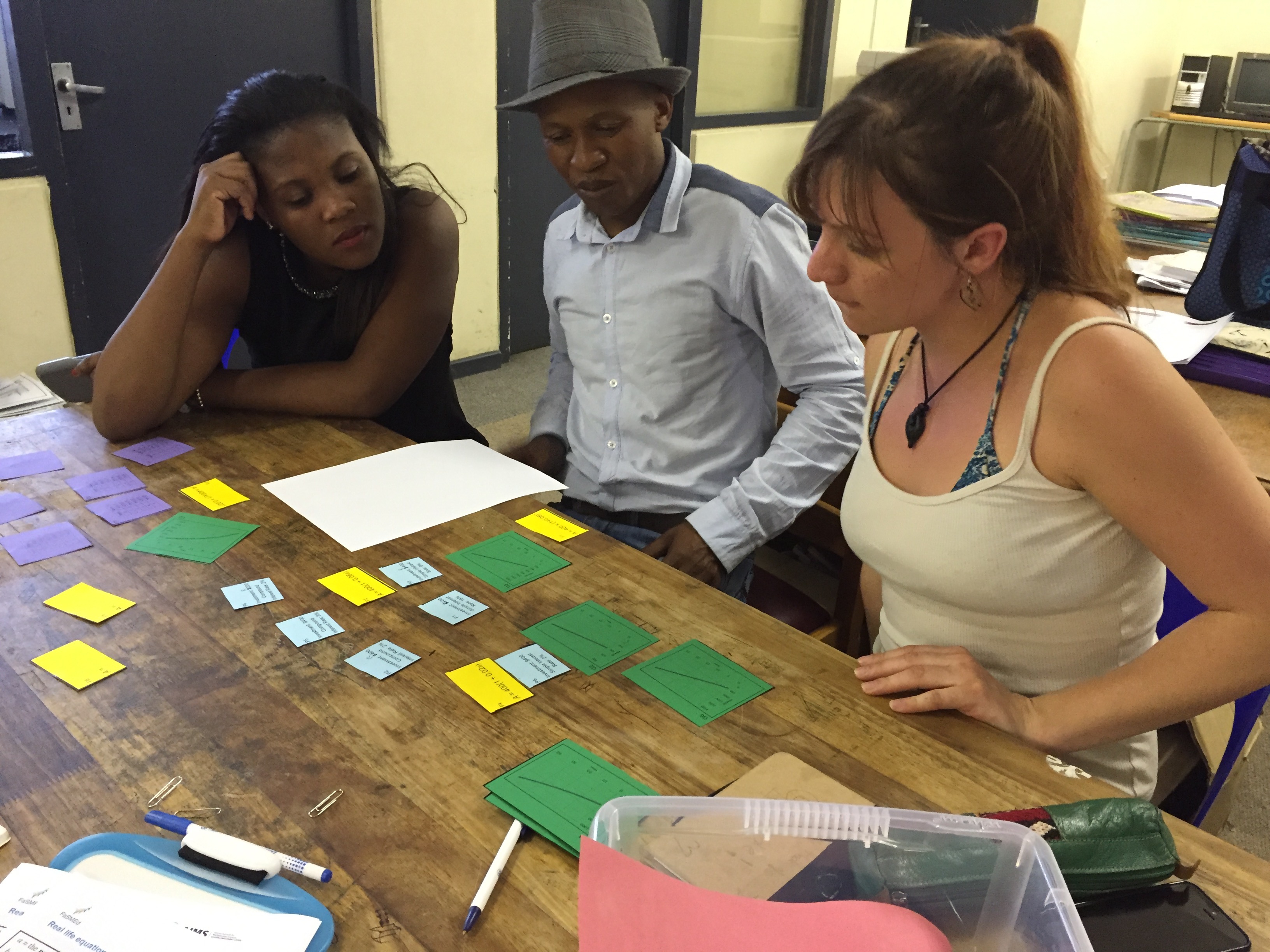Workshop 1
Details
Date: 2 March 2016
Time: 2:45 pm
Present: Marie Joubert and Ingrid Mostert (AIMSSEC)
Toni Beardon (AIMSSEC, observer)
Bulelani Hlakula (Vuyiseka SS)
Noloyiso Nkanunu and Luzuko Hoyi (joined later) (Vuyiseka SS)
Apologies: Severino Sedeya
Notes
To begin, only Bulelani was present. We discussed postponing the workshop but he said he would like us to run it anyway.
We asked Toni to work with Bulelani and provided them with a sheet of poster paper, some Prestick and two sets of small cards. We explained that on one set there are equations in a, b, x and y and on the other are descriptions. We told them what the variables a, b, x and y represent and said that the activity is to find cards from the different sets that are equivalent. They began to work on the activity, discussing both the mathematics and possible learner responses to the activity as they worked.
 Figure 1: Bulelani and Toni working on the activity
Figure 1: Bulelani and Toni working on the activity
The other two teachers joined us after 15 minutes and we briefly introduced the activity. They worked as a pair.
Once Bulelani and Toni had completed the activity and the other two teachers had matched many of the cards we stuck up big versions of the small cards on the board and went through the matches. As a group, we discussed the importance of emphasising to the learners that they should pay attention to what the variables represent.
 Figure 2: Ingrid discussing the card matches
Figure 2: Ingrid discussing the card matches
The meeting came to an end and a follow-up meeting, for discussion about how the activity can be used in the classroom for formative assessment, was scheduled for 17th March.
Workshop 2
Details
Date: 17 March 2016
Time: 2:45 pm (but started at 3:20)
Present: Marie Joubert (AIMSSEC)
Philippa Carson (Carson Content Creation, observer)
Bulelani Hlakula and Noloyiso Nkanunu (Vuyiseka SS)
Apologies: Severino Sedeya
Notes
The meeting began at 3:20 as there was some delay in locating the teachers. As both teachers had been present at the previous meeting, I asked if they wanted to look in more detail at the interpreting equations lesson, or if they wanted to look at something new. Bulelani opted for the latter so I introduced the main (small group) activity for the comparing investments lesson and suggested that the two teachers should attempt the task. Philippa also joined with them, see Figure 1 below.

Figure 1: Beginning the activity
By 3:37 they had matched all the cards and worked out where the four ‘evaluation’ cards go as shown in Figure 2 below.
 Figure 2: Completed card activity
Figure 2: Completed card activity
We discussed possible learner responses to the task. I described how the learners in Severino’s class had appeared to be fully engaged with the task and said that I was confident that the learners in other classes would also find the task engaging, but asked what did they think the learners would be learning. The teachers suggested it was a problem solving activity, involving skills of estimation, comparison, elimination. We discussed that the learners would be developing an understanding of the different ways in which an investment could be represented. Bulelani said that if he was teaching the lesson he would emphasise the need to compare like with like (referring to the different time-scale on the graphs). He said he would use the activity to situate the mathematical learning in the real world.
I said that if the teachers wanted to try the task with their classes, we would be happy to support them but we would leave it to them to contact us.
Bulelani asked if we would be willing to run an after-school workshop involving learners and teachers. We will be contacting the school about this in May 2016.
The meeting ended at 4.